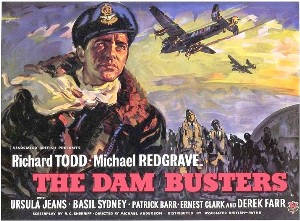
The Dam Busters is a 1955 British epic war film starring Richard Todd and Michael Redgrave. It was directed by Michael Anderson. The film recreates the true story of Operation Chastise when in 1943 the RAF's 617 Squadron attacked the Möhne, Eder, and Sorpe dams in Nazi Germany with Barnes Wallis's bouncing bomb.
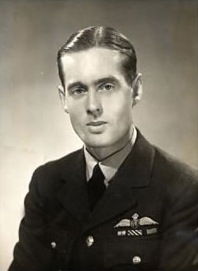
Geoffrey Leonard Cheshire, Baron Cheshire, was a highly decorated Royal Air Force (RAF) pilot and group captain during the Second World War, and a philanthropist.

Operation Chastise, commonly known as the Dambusters Raid, was an attack on German dams carried out on the night of 16/17 May 1943 by 617 Squadron RAF Bomber Command, later called the Dam Busters, using special "bouncing bombs" developed by Barnes Wallis. The Möhne and Edersee dams were breached, causing catastrophic flooding of the Ruhr valley and of villages in the Eder valley; the Sorpe Dam sustained only minor damage. Two hydroelectric power stations were destroyed and several more damaged. Factories and mines were also damaged and destroyed. An estimated 1,600 civilians – about 600 Germans and 1,000 enslaved labourers, mainly Soviet – were killed by the flooding. Despite rapid repairs by the Germans, production did not return to normal until September. The RAF lost 56 aircrew, with 53 dead and 3 captured, amid losses of 8 aircraft.
The Dam Busters may refer to:

Wing Commander Guy Penrose Gibson, was a distinguished bomber pilot in the Royal Air Force during the Second World War. He was the first Commanding Officer of No. 617 Squadron, which he led in the "Dam Busters" raid in 1943, resulting in the breaching of two large dams in the Ruhr area of Germany. He was awarded the Victoria Cross, the highest award for gallantry in the face of the enemy that can be awarded to British and Commonwealth forces, in the aftermath of the raid in May 1943 and became the most highly decorated British serviceman at that time. He completed over 170 war operations before being killed in action at the age of 26.

A bouncing bomb is a bomb designed to bounce to a target across water in a calculated manner to avoid obstacles such as torpedo nets, and to allow both the bomb's speed on arrival at the target and the timing of its detonation to be pre-determined, in a similar fashion to a regular naval depth charge. The inventor of the first such bomb was the British engineer Barnes Wallis, whose "Upkeep" bouncing bomb was used in the RAF's Operation Chastise of May 1943 to bounce into German dams and explode underwater, with effect similar to the underground detonation of the later Grand Slam and Tallboy earthquake bombs, both of which he also invented.

Number 617 Squadron is a Royal Air Force aircraft squadron, originally based at RAF Scampton in Lincolnshire and currently based at RAF Marham in Norfolk. It is commonly known as "The Dambusters", for its actions during Operation Chastise against German dams during the Second World War. In the early 21st century it operated the Panavia Tornado GR4 in the ground attack and reconnaissance role until being disbanded on 28 March 2014. The Dambusters reformed on 18 April 2018, and was equipped at RAF Marham in June 2018 with the Lockheed Martin F-35B Lightning, becoming the first squadron to be based in the UK with this advanced V/STOL type. The unit is composed of both RAF and Royal Navy personnel, and operates from the Royal Navy's Queen Elizabeth-class aircraft carriers.

Tallboy or Bomb, Medium Capacity, 12,000 lb was an earthquake bomb developed by the British aeronautical engineer Barnes Wallis and used by the Royal Air Force (RAF) during the Second World War.

No. 5 Group RAF was a Royal Air Force bomber group of the Second World War, led during the latter part by AVM Sir Ralph Cochrane.
Paul Chester Jerome Brickhill was an Australian fighter pilot, prisoner of war, and author who wrote The Great Escape, The Dam Busters, and Reach for the Sky.
John Sleigh Pudney was a British poet, journalist and author. He was known especially for his popular poetry written during the Second World War, but he also wrote novels, short stories and children's fiction. His broad-ranging non-fiction, often commissioned, served as his primary source of income.

The British "Victory Bomber" was a Second World War design proposal by British inventor and aircraft designer Barnes Wallis while at Vickers-Armstrongs for a large strategic bomber. This aircraft was to have performed what Wallis referred to as "anti-civil engineering" bombing missions and was to have carried his projected 22,000 lb (10,000 kg) "earthquake bomb" to strategic targets in Germany. The Victory Bomber was considered extremely ambitious: the Royal Air Force (RAF) at that time not yet having introduced four-engine heavy bombers, and to give the necessary performance, the Victory Bomber was to have six engines and was highly specialised to its role.
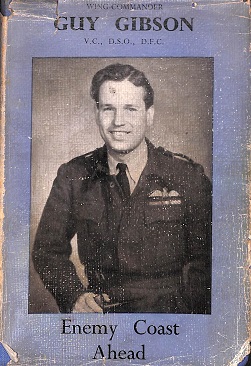
Enemy Coast Ahead is an autobiographical book recounting the World War II flying career of Wing Commander Guy Gibson VC, DSO, DFC. It covers his time in RAF Bomber Command from the very earliest days of war in 1939 through to 1943.

Squadron Leader John Leslie Munro, was a Royal New Zealand Air Force pilot during World War II and the last surviving pilot of the Dambusters Raid of May 1943.

David John Shannon, DSO & Bar, DFC & Bar was an Australian bomber pilot of World War II, known for his part in the "Dambusters" raid on the night of 16/17 May 1943. Born in South Australia, Shannon joined the Royal Australian Air Force (RAAF) in 1941 and learned to fly under the Empire Air Training Scheme. After further training in the United Kingdom he was posted to No. 106 Squadron RAF, operating Avro Lancaster heavy bombers, and was awarded the Distinguished Flying Cross (DFC) in January 1943.

Squadron Leader David John Hatfeild Maltby, was a bomber pilot in the Royal Air Force, best known for his part as the pilot of Lancaster AJ-J (“Johnny”) in the Dambusters raid. He had successfully completed over 30 operations before his death in September 1943.
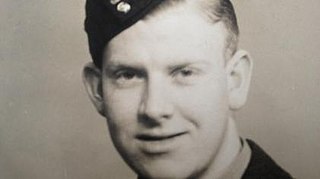
Frederick "Freddie" Tees was a member of No. 617 Squadron of the Royal Air Force who took part in Operation Chastise, the "Dambusters" raid of 1943, as a rear gunner. The raid was the inspiration for the 1955 film The Dam Busters. He ended his days as a barber in Letchworth.

John Vere Hopgood, was a pilot with No. 617 Squadron of the Royal Air Force (RAF). He was killed in action while taking part in Operation Chastise, popularly known as the 'Dam Busters' raid.
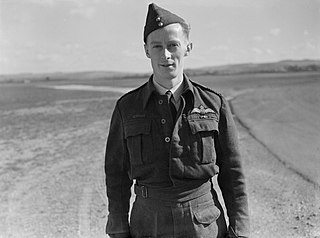
Wing Commander George Walton Holden, was a British aviator and a pilot in RAF Bomber Command during the Second World War. He was briefly commander of No. 617 Squadron RAF—"The Dam Busters"—before his death.
Henry Eric Maudslay, DFC was a pilot with No. 617 Squadron of the Royal Air Force (RAF). He was killed in action while taking part in Operation Chastise, popularly known as the 'Dam Busters' raid.
















